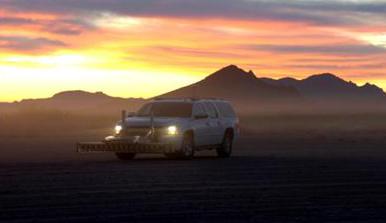Detection of buried objects is critical to safe operation when digging or operating vehicles around gas pipe-lines, electrical cables, buried explosives, or other hidden hazards. Operators of construction equipment or mobile platforms need to be able to evaluate potential hazards prior to placing themselves or their vehicles in danger. LLNL is now offering a technology to meet this need by imaging the subsurface and providing these images with an automated detection algorithm in real-time.
LLNL has developed a wide band (WB) ground penetrating radar (GPR) technology to detect and image buried objects under a moving vehicle. Efficient and high performance processing algorithms reconstruct images of buried or hidden objects in two or three dimensions under a scanning array. The technology includes a mobile high-performance computing system allowing GPR array sensor data to be processed to form subsurface images which are displayed to the vehicle operator in real-time. The components of this technology, an array of radars and antennas, signal processing system, and operator interface are integrated and adaptable to utility or tactical vehicles operating on or off road.
Existing systems operate in multi-monostatic mode (when any antenna transmits, only the corresponding antenna receives), and they detect buried threats by analyzing received GPR directly. LLNL’s system sees deeper than existing systems, operates in a multi-static mode for better image formation, and utilizes inexpensive radar transmitter and receiver technology.
This technology is ideally suited for buried explosives detection, humanitarian demining operations, or utility line, pipe-line, or cable detection prior to digging for the construction industry.
LLNL has filed patent applications for this technology and developed a demonstration system that has confirmed performance both at an on-site test course as well as at an off-site desert location.


